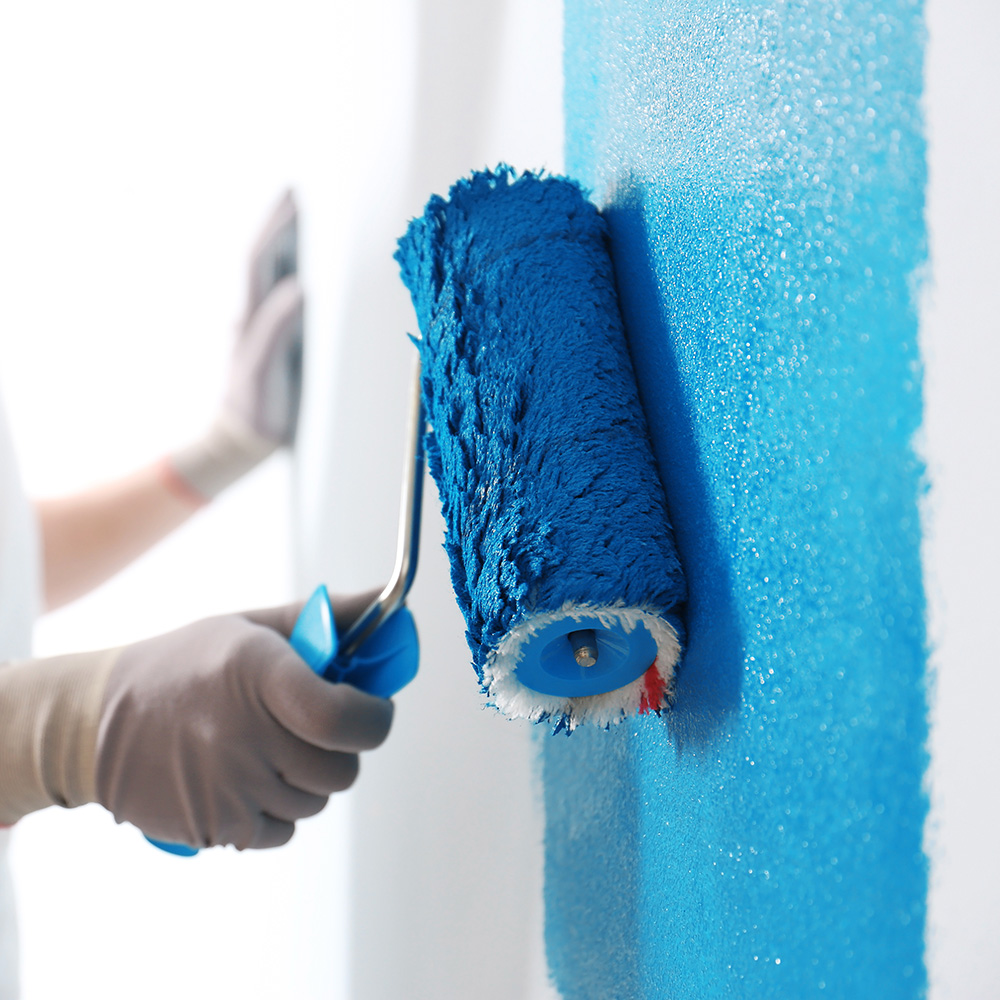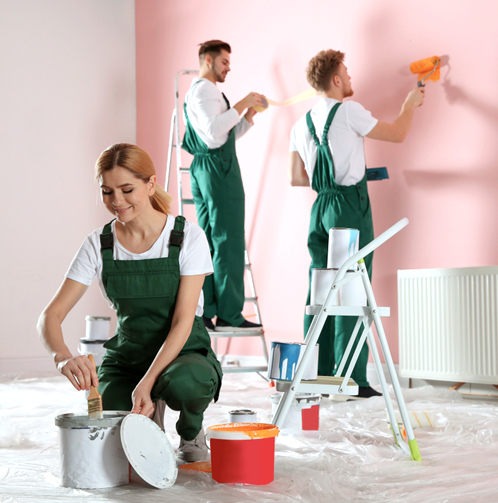Discovering the Various Types of Paint: An Overview for every single Job
Checking out the various kinds of paint is crucial for attaining the preferred outcome in any kind of task. From water-based choices that offer ease to oil-based paints recognized for their sturdiness, each choice has its merits. Specialized paints can add unique appearances or surfaces, while eco-friendly choices provide to those looking for sustainability. Comprehending these distinctions can substantially affect the success of a painting venture. What factors should one take into consideration when making the best choice?
Comprehending Paint Types: Oil-Based vs. water-based
Paint types can markedly affect a task's result, and recognizing the differences in between water-based and oil-based paints is necessary for informed decision-making. Water-based paints, usually referred to as latex paints, are made up of water as the primary solvent. They dry promptly, release less volatile natural substances (VOCs), and are easy to cleanse up with soap and water. This makes them a popular option for indoor applications and environments where air high quality is a problem.
In contrast, oil-based paints utilize natural solvents, providing a long lasting, shiny finish suitable for surface areas revealed to deterioration, such as trim and cupboards. They take longer to completely dry, require mineral spirits for cleanup, and have a more powerful odor. benjamin moore paint store corpus christi. Selecting in between these 2 kinds depends on the particular requirements of the task, considering factors such as preferred surface, application atmosphere, and convenience of upkeep. Each kind has distinct advantages and limitations, directing the choice process
The Complete Matters: Selecting Between Matte, Satin, and Gloss
When choosing a paint surface, the option between matte and glossy choices considerably influences both aesthetics and functionality. Matte finishes offer a subtle, non-reflective appearance that can conceal surface area blemishes, while shiny coatings provide toughness and simplicity of cleaning. Comprehending the benefits and considerations of each can aid in making an educated choice for any type of painting project.
Matte Finish Advantages
Although several home owners dispute the values of different finishes, matte paint offers distinctive benefits that make it a prominent choice for both exterior and interior applications. Among the main advantages of matte finish is its capacity to hide surface area flaws, creating a smoother look on walls. This top quality is particularly helpful in older homes or spaces with irregular surfaces. In addition, matte paint takes in light as opposed to reflecting it, which can improve the aesthetic of a space by providing a much more muted and advanced look. In addition, matte finishes are frequently less complicated to touch up than glossier alternatives, as they can blend much more flawlessly when applied over existing paint. Generally, matte paint is an exceptional selection for those looking for a fine-tuned and elegant surface.
Shiny Finish Considerations
A glossy surface can significantly change the assumption of a room, offering a streamlined and reflective high quality that boosts both shade vibrancy and light within an area. This finish is typically preferred for high-traffic locations and surface areas like bathroom and kitchens, where sturdiness and convenience of cleansing are essential. Its reflective nature can highlight flaws on wall surfaces, making appropriate surface area prep work important. Shiny paints additionally often tend to reveal fingerprints and spots a lot more conveniently, demanding routine upkeep. Furthermore, illumination plays a considerable role; in bright environments, a glossy coating might produce glare, impacting the overall aesthetic. Subsequently, mindful consideration of the certain application and atmosphere is crucial when selecting a glossy finish for any kind of job.
Specialty Paints: When to Make Use Of Distinctive or Chalk Paint
Specialty paints, such as distinctive and chalk paint, deal distinct visual and functional benefits that can enhance numerous surfaces. Distinctive paint is suitable for developing depth and dimension on walls, hiding blemishes while adding a three-dimensional feeling. It is especially beneficial in high-traffic locations where toughness and visual passion are crucial.

Both kinds of specialty paints can change areas, however picking the appropriate one relies on the wanted impact and surface requirements. Distinctive paint might suit bigger areas, while chalk paint can rejuvenate smaller products, showcasing creativity and personal style in any project.
Exterior Paints: Shielding Your Surface Areas From the Aspects
Outdoor paints are essential for safeguarding surface areas against various climate condition. Understanding their weather resistance attributes, correct surface preparation needs, and efficient application techniques can substantially improve resilience and efficiency. This section will certainly describe key considerations for picking and making use of outside paints effectively.
Climate Resistance Features
Climate resistance is a necessary feature of exterior paints, as it identifies just how well surfaces can stand up to the severe components of nature. Top quality exterior paints are formulated to stand up to damage from UV rays, wetness, and temperature level fluctuations. UV resistance warranties colors stay vivid in time, protecting against fading and staining. Wetness resistance shields against mold and mold, which can compromise the stability of surface areas. In addition, paints with outstanding temperature level resistance can acquire and increase without cracking, preserving their safety top qualities. When selecting outside paints, it is essential to think about these weather resistance functions, as they add to the long life and resilience of colored surface areas, making particular they remain aesthetically pleasing and practical despite exposure to the elements.
Surface Preparation Demands
Proper surface preparation is a fundamental step in accomplishing the finest outcomes with outside paints. To ensure excellent attachment and durability, surfaces must be thoroughly cleaned, removing grease, mildew, and dirt. This can be achieved using a stress washing machine or a scrub brush with an ideal cleansing option. Once cleaned up, surfaces ought to be examined for any peeling or flaking paint, which must be scraped away to develop a smooth structure. Fixing any type of openings or fractures is likewise vital, as these can enable moisture seepage. Furthermore, sanding harsh locations promotes better paint attachment. Applying a guide fit for outdoor usage can enhance the paint's efficiency, ensuring a lasting coating that stands up to the elements. Proper prep work is essential to a successful exterior painting project.
Application Techniques Tips
While using outdoor paints, it is necessary to make use of efficient techniques that assure surfaces are well-protected versus the elements. Pick the right day for paint; reduced humidity and light temperatures boost adhesion and drying out. Prepping the surface area completely-- cleansing, sanding, and priming-- guarantees far better paint adhesion and durability. Utilizing high-quality brushes or rollers can offer a smoother surface, while spray paint may cover big locations efficiently. Using paint in slim, even layers prevents drips and runs. It is a good idea to adhere to manufacturer directions relating to drying out times between layers. Confirm correct ventilation during application to assist in drying out and decrease exposure to fumes. These techniques considerably boost the longevity and efficiency of exterior paint.
Eco-Friendly Options: Low-VOC and Zero-VOC Paints
As consumers end up being progressively familiar with the ecological effect of their selections, zero-voc and low-voc paints have become prominent options. These paints are developed to consist of fewer unstable organic compounds (VOCs), which are chemicals that can evaporate into the air and contribute to air pollution and illness. Low-VOC here are the findings paints generally contain a restricted quantity of VOCs, while zero-VOC paints have negligible levels, making them safer for both interior and outside use.
The benefits of utilizing low-VOC and zero-VOC paints extend beyond ecological factors to consider; they also boost indoor air top quality, decreasing the risk of respiratory problems and allergic responses. Numerous manufacturers currently supply a variety of shades and surfaces in eco-friendly options, making it easier for customers to locate suitable products for their projects. By choosing these paints, individuals can add to a much healthier setting while still achieving the aesthetic they want in their areas.
Tools and Strategies for a Flawless Application
Achieving a perfect paint application calls for the right devices and strategies, which can significantly enhance the last result. Picking the ideal brush or roller is essential; brushes function well for sides and elaborate areas, while rollers cover larger surface areas successfully. Utilizing top quality products assures much better paint distribution and reduces touches. For suitable results, surface area preparation is important. This includes cleansing, sanding, and priming Check Out Your URL surfaces to advertise bond.
Technique also plays a considerable role. The "W" method with a roller assists to uniformly disperse paint, while long, smooth strokes with a brush prevent noticeable lines. Operating in sections permits far better control and mixing. In addition, using slim coats is better to thick layers, lowering the danger of drips and uneven structures. Lastly, maintaining a damp side during application assists achieve smooth changes between areas. By combining these devices and techniques, one can attain a refined and expert coating.
Tips for Preserving and Taking Care Of Your Painted Surfaces
Proper maintenance and care of colored surface areas can greatly extend their life-span and preserve their appearance. Regular cleaning is essential; making use of a soft towel or sponge with moderate soap and water can get rid of dust and dust without harming the paint. It is a good idea to prevent rough cleaners or rubbing pads, as these can scrape the surface. Furthermore, applying a fresh layer of paint every couple of years can secure and invigorate the shade against wear.
For outside surfaces, examining for indications of peeling or fading consistently is essential. Promptly resolving any issues stops further damage. In areas vulnerable to dampness, such as restrooms, using mold-resistant paint and making sure proper ventilation can aid keep the stability of the paint. Lastly, using safety surfaces can secure against UV rays and discolorations, making certain that painted surfaces remain enticing and dynamic for several years ahead, inevitably improving the general visual of the space.
Often Asked Questions
Can I Mix Different Kind Of Paint Together?
Blending various kinds of paint is generally not advised, as it can lead to issues like inadequate adhesion, irregular texture, or unanticipated chemical responses. It's ideal to use compatible paints for ideal results and sturdiness.

Just how Do I Properly Store Extra Paint?
To appropriately save leftover paint, seal the container firmly, tag it with the date and color, and maintain it in a cool, completely dry location away from direct sunlight and severe temperature levels for ideal preservation.
What Is the most effective Means to Take Care Of Unused Paint?
The very best way to deal with unused paint is Home Page to inspect regional laws, as several areas have actually marked contaminated materials facilities. Alternatively, take into consideration giving away functional paint to area companies or schools for their tasks.
How Can I Tell if Paint Is Still Excellent to Utilize?
To determine if paint is still excellent, examine its uniformity, color, and odor. If it appears apart, has an unpleasant odor, or reveals considerable modifications in structure, it's most likely no more useful.
Are There Age Restrictions for Buying Paint Products?
In several areas, there are no specific age limitations for acquiring paint products. Some shops might require consumers to be at least 18 years old, particularly for products consisting of solvents or hazardous materials.
Paint types can markedly influence a task's result, and comprehending the distinctions in between water-based and oil-based paints is necessary for informed decision-making. Water-based paints, frequently referred to as latex paints, are composed of water as the primary solvent. In contrast, oil-based paints utilize natural solvents, supplying a sturdy, glossy coating ideal for surface areas subjected to tear and wear, such as trim and cabinets. Specialty paints, such as distinctive and chalk paint, offer distinct aesthetic and practical benefits that can boost different surfaces. In locations prone to wetness, such as bathrooms, utilizing mold-resistant paint and making certain correct ventilation can assist maintain the honesty of the paint.